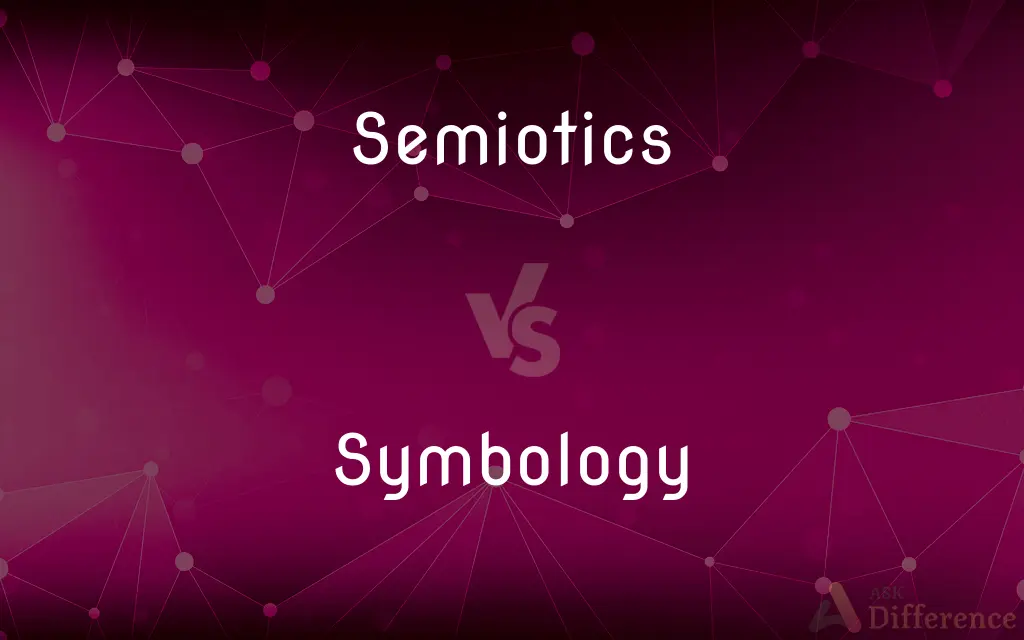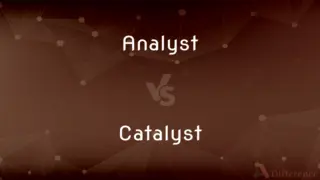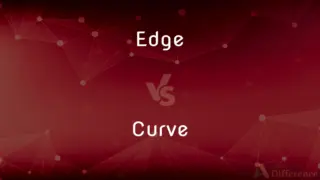Semiotics vs. Symbology — What's the Difference?
By Fiza Rafique & Maham Liaqat — Updated on April 14, 2024
Semiotics studies signs and their meanings in context, focusing on communication systems; symbology specifically examines symbols, their meanings, and their cultural significance.

Difference Between Semiotics and Symbology
Table of Contents
ADVERTISEMENT
Key Differences
Semiotics is an interdisciplinary study that explores how meaning is created and understood through various signs and symbols within communication systems. On the other hand, symbology is a narrower field that concentrates solely on the interpretation of symbols and their significance within specific cultural or philosophical contexts.
In semiotics, signs can include anything that conveys meaning, such as words, images, sounds, gestures, and objects. Whereas, symbology deals explicitly with symbols, which are signs that represent ideas or concepts, often with deep cultural or historical implications.
Semioticians analyze the structure and processes of sign systems like language, gestures, and media. Conversely, symbologists often focus on specific types of symbols, such as religious icons, logos, or national emblems, studying their evolution and roles within societies.
Semiotics applies theories and models to understand how meaning is constructed and interpreted across different forms of communication. On the other hand, symbology often involves the study of symbolic meanings as fixed or traditional within a particular cultural or temporal frame.
The field of semiotics includes various branches such as semantics, syntactics, and pragmatics, each looking at different aspects of how signs function. Symbology, however, generally does not delve into such distinctions, focusing instead on the direct study of symbols and their meanings.
ADVERTISEMENT
Comparison Chart
Definition
Study of signs and sign processes
Study of symbols and meanings
Focus
Meaning creation and interpretation
Symbolic representation
Scope
Broad, interdisciplinary
Narrow, often cultural specific
Main Branches
Semantics, syntactics, pragmatics
Lacks distinct branches
Example Application
Media analysis, linguistics
Religious iconography, logos
Compare with Definitions
Semiotics
The theory of signs and symbols in relation to their functions and meanings.
In semiotics, a red light serves as a sign to stop.
Symbology
The study of symbols and their meanings within cultural contexts.
Symbology often involves decoding the symbolism in religious texts.
Semiotics
The analysis of sign processes, including denotation and connotation.
Semiotics distinguishes between the literal and implied meanings of words.
Symbology
The analysis of how symbols convey specific ideas or beliefs.
In symbology, a dove typically symbolizes peace.
Semiotics
The examination of how humans derive meaning from contextually based entities.
Semiotics often explores the role of gestures in communication.
Symbology
A branch of knowledge that deals with the history and significance of symbols.
Symbology can help interpret ancient symbols found in archeological digs.
Semiotics
A field studying how meaning is communicated through established sign systems.
Semiotics analyzes how images in advertisements convey consumer messages.
Symbology
The examination of symbolic representations across different cultures.
Symbology explores how different cultures perceive the color black.
Semiotics
The study of signs across various cultural, social, and linguistic contexts.
Semiotics can explain how emojis are used to convey emotions in texts.
Symbology
The study focusing on the role of symbols in communication and tradition.
Symbology investigates how national flags inspire patriotism.
Semiotics
Semiotics (also called semiotic studies) is the study of sign processes (semiosis), which are any activity, conduct, or process that involves signs, where a sign is defined as anything that communicates a meaning that is not the sign itself to the sign's interpreter. The meaning can be intentional such as a word uttered with a specific meaning, or unintentional, such as a symptom being a sign of a particular medical condition.
Symbology
The study or interpretation of symbols or symbolism.
Semiotics
The theory and study of signs and symbols, especially as elements of language or other systems of communication, and comprising semantics, syntactics, and pragmatics.
Symbology
The use of symbols.
Semiotics
The study of signs and symbols, especially as means of language or communication.
Social science
Symbology
(uncountable) The study or use of symbols.
Semiotics
(dated) The study of medical signs and symptoms; symptomatology.
Symbology
(countable) An encoding scheme, particularly for barcodes.
Semiotics
Same as Semeiotics.
Symbology
The art of expressing by symbols.
Semiotics
(philosophy) a philosophical theory of the functions of signs and symbols
Common Curiosities
Can semiotics be applied to digital communications?
Yes, semiotics can analyze any communicative content, including digital media like websites and social networks.
What are some common symbols studied in symbology?
Common symbols include religious icons, cultural symbols, and logos.
What is symbology?
Symbology is the study of symbols, especially the analysis of symbolic meanings within different cultures.
Are semiotics and symbology used in marketing?
Yes, both fields can be applied to marketing to better understand and craft effective communications.
Do semiotics and symbology require a background in linguistics?
Semiotics often benefits from linguistic knowledge, whereas symbology can be approached from broader cultural studies.
What is semiotics?
Semiotics is the study of signs and symbols, particularly how meanings are constructed and understood.
How do semiotics and symbology differ?
Semiotics is broader, covering all sign systems and their meanings, while symbology focuses specifically on symbols and their cultural implications.
Can semiotics be taught at the university level?
Semiotics is widely taught in various academic programs, including communications and cultural studies.
What is a practical application of symbology?
Symbology can be practically applied in areas like art analysis and cultural heritage preservation.
How do semiotics and symbology approach the study of language?
Semiotics considers language one of many sign systems, while symbology might focus on specific symbolic uses of language.
What tools do semioticians use?
Semioticians use tools like structural analysis to decode various types of sign systems.
Is there a philosophical aspect to semiotics?
Yes, semiotics often touches on how meaning is constructed, which can be considered a philosophical inquiry.
Can the study of semiotics aid in intercultural communication?
Understanding semiotics can greatly enhance intercultural communication by decoding context-dependent meanings.
What makes a symbol significant in symbology?
In symbology, a symbol's significance often stems from its historical, cultural, or religious relevance.
What skills are important for a symbologist?
Important skills include cultural knowledge, analytical thinking, and understanding of historical contexts.
How do semiotics and symbology relate to anthropology?
Both fields can intersect with anthropology when exploring how cultures communicate and symbolize ideas.
Share Your Discovery

Previous Comparison
Analyst vs. Catalyst
Next Comparison
Edge vs. CurveAuthor Spotlight
Written by
Fiza RafiqueFiza Rafique is a skilled content writer at AskDifference.com, where she meticulously refines and enhances written pieces. Drawing from her vast editorial expertise, Fiza ensures clarity, accuracy, and precision in every article. Passionate about language, she continually seeks to elevate the quality of content for readers worldwide.
Co-written by
Maham Liaqat













































